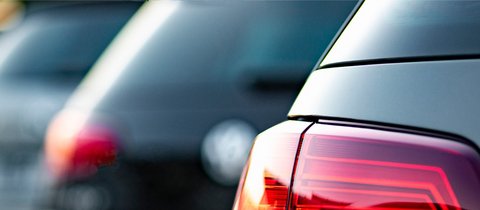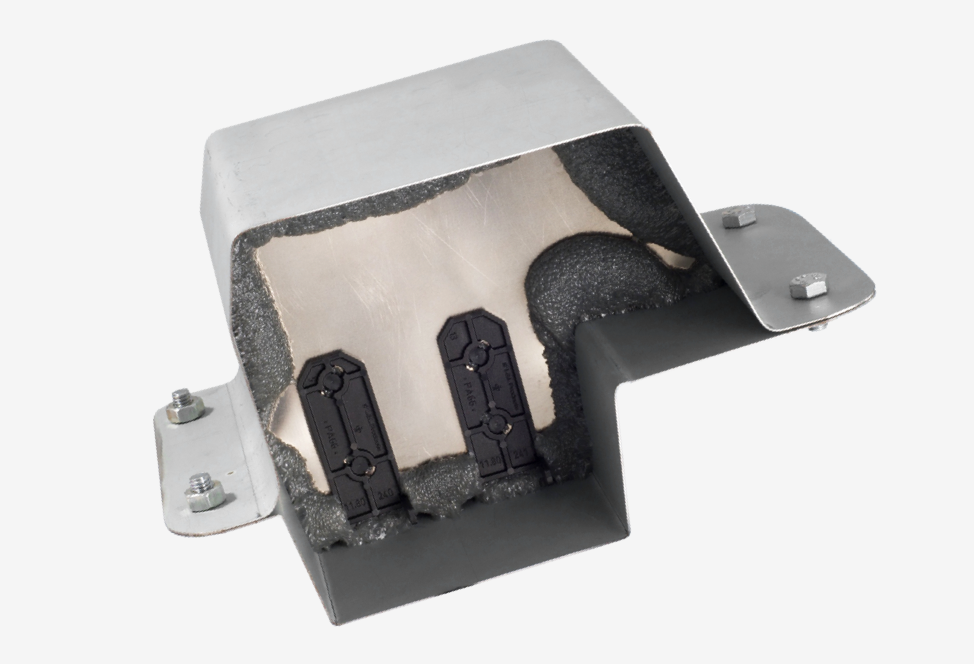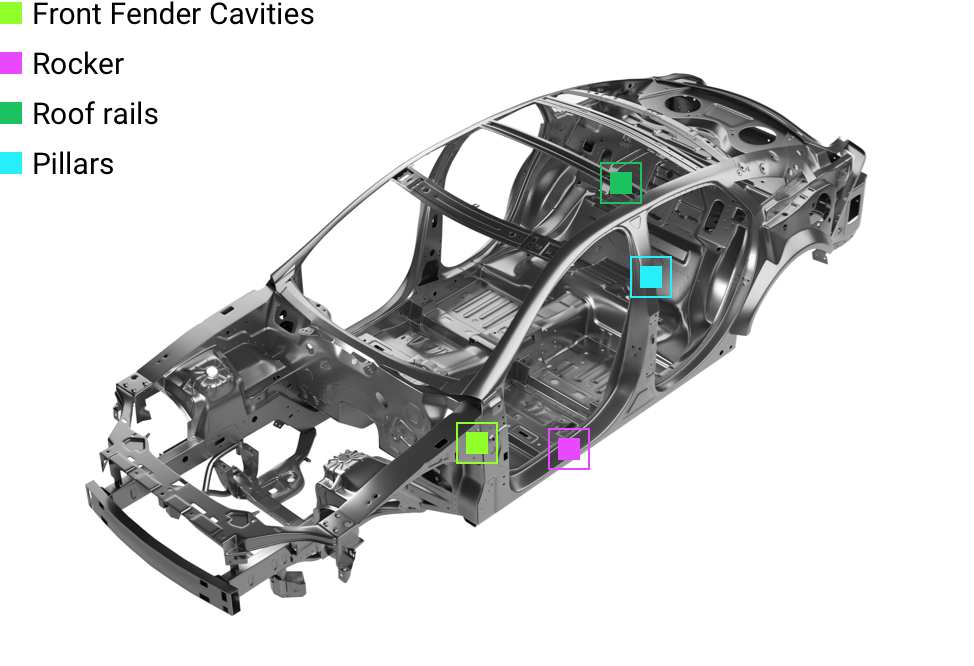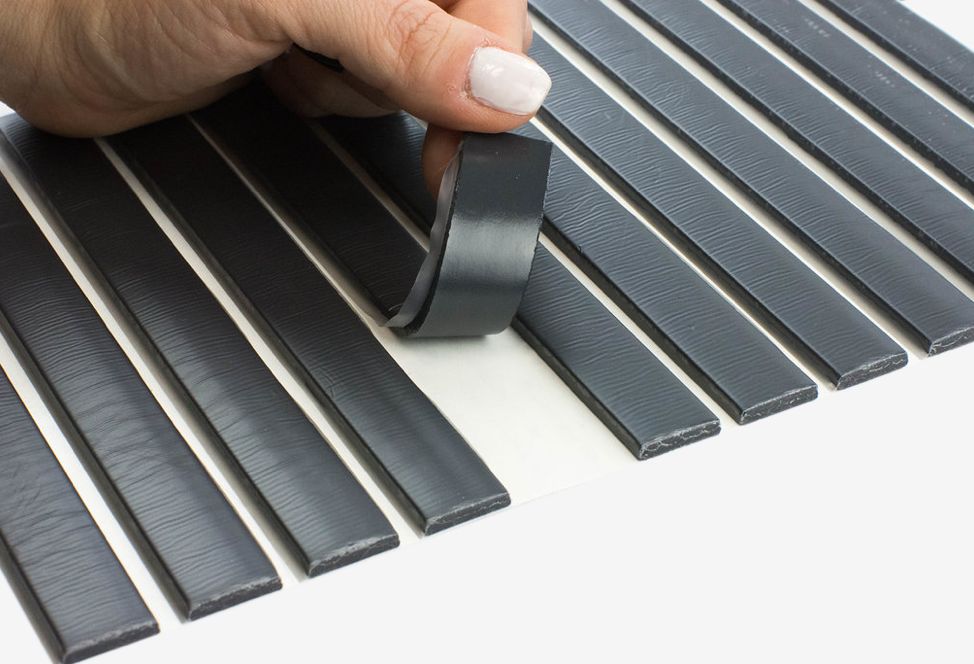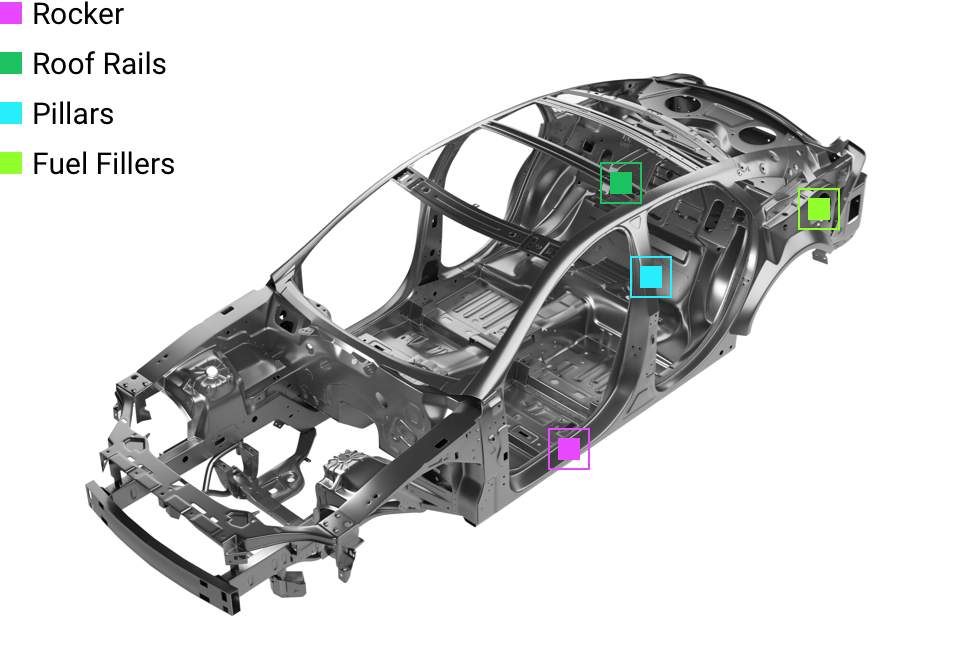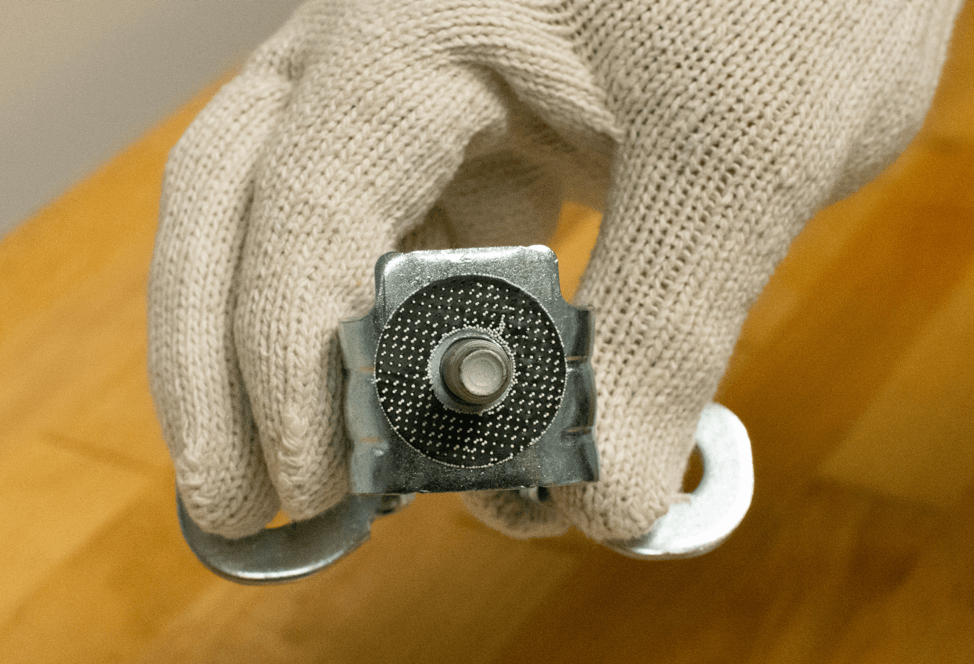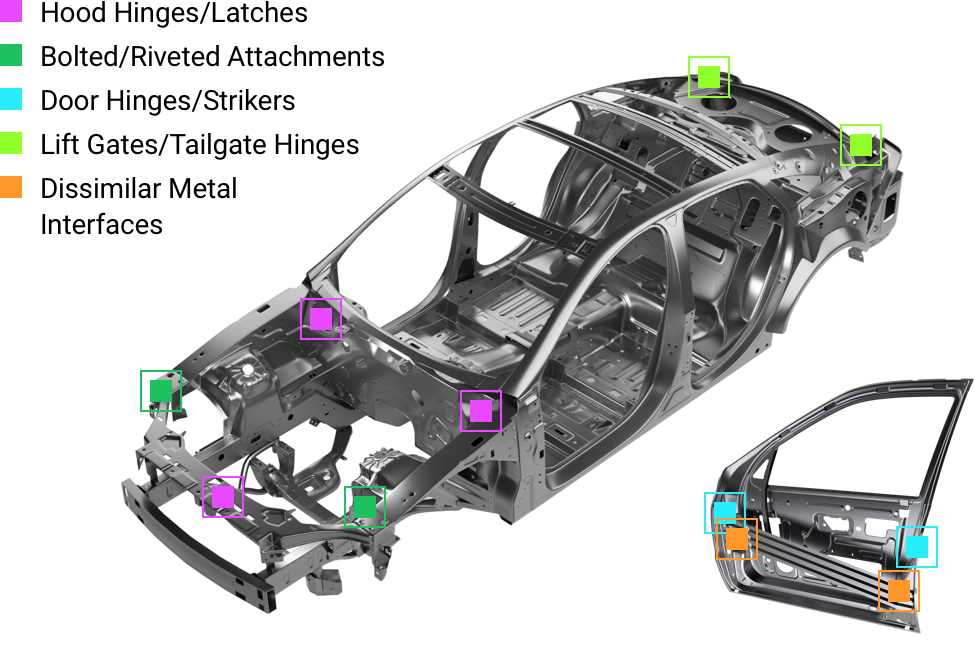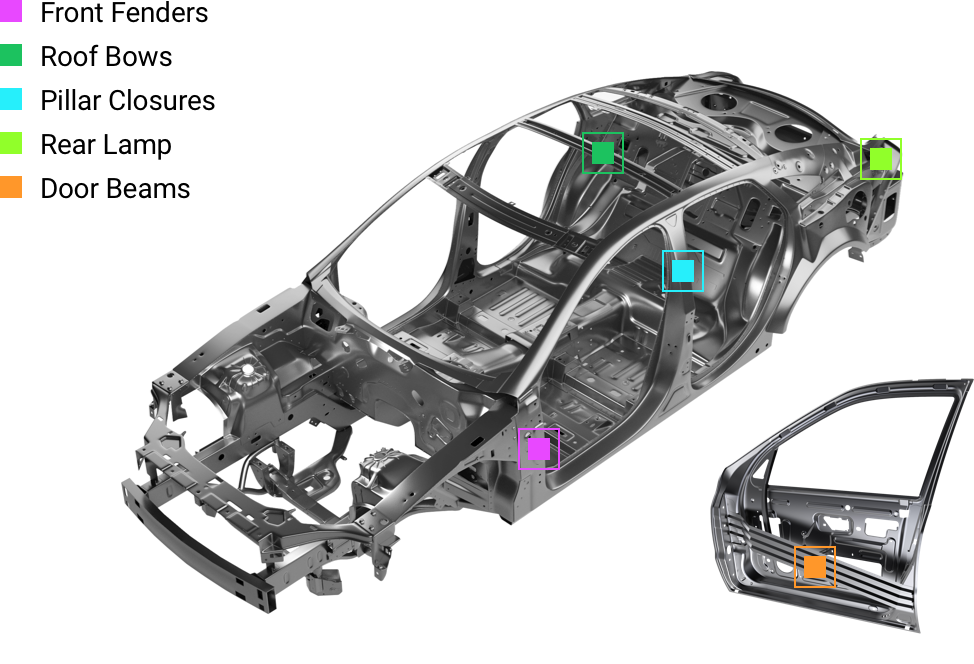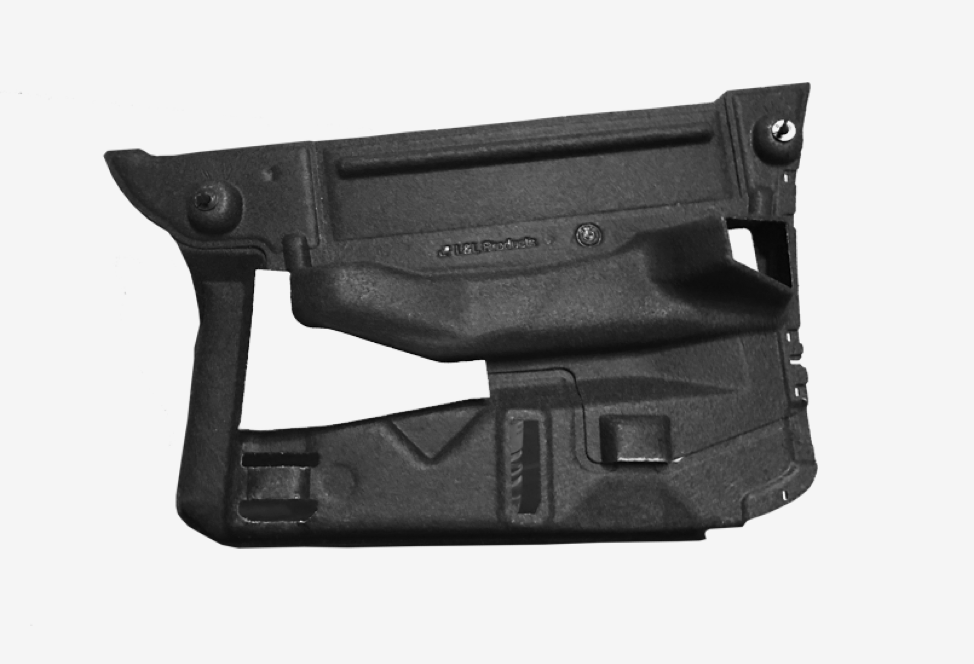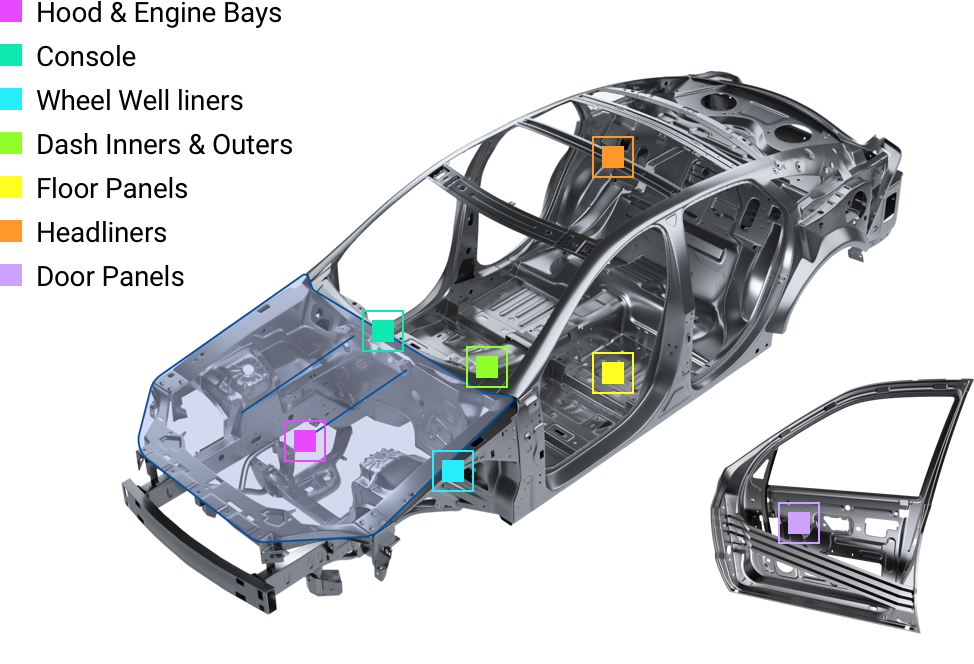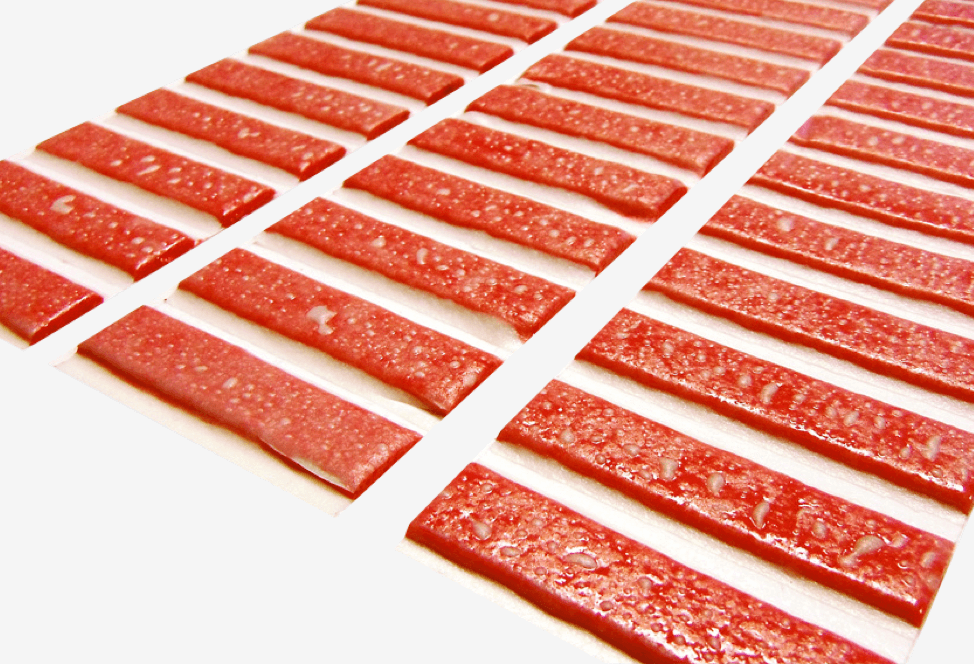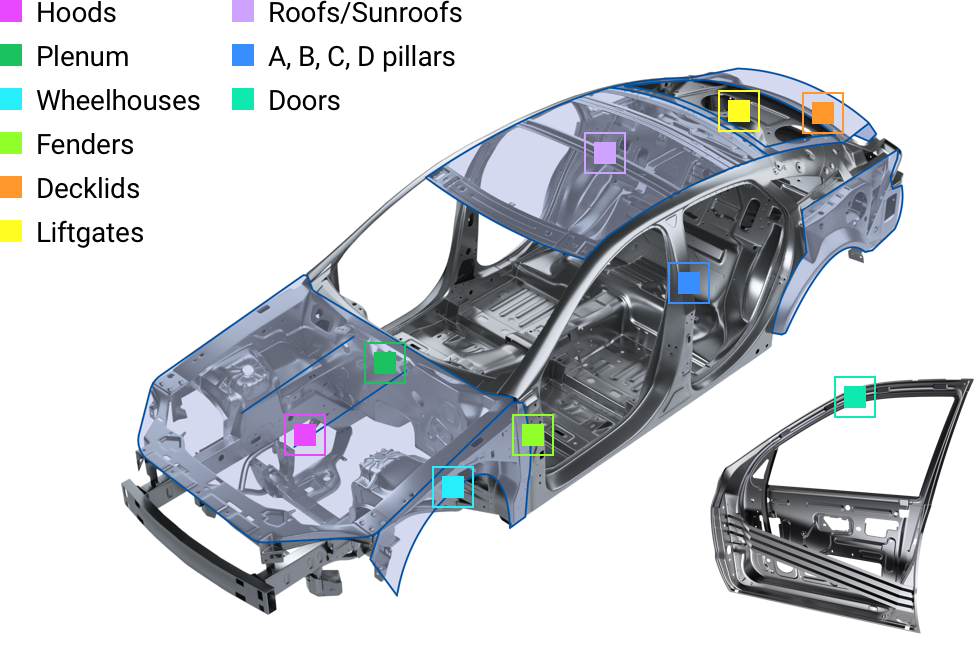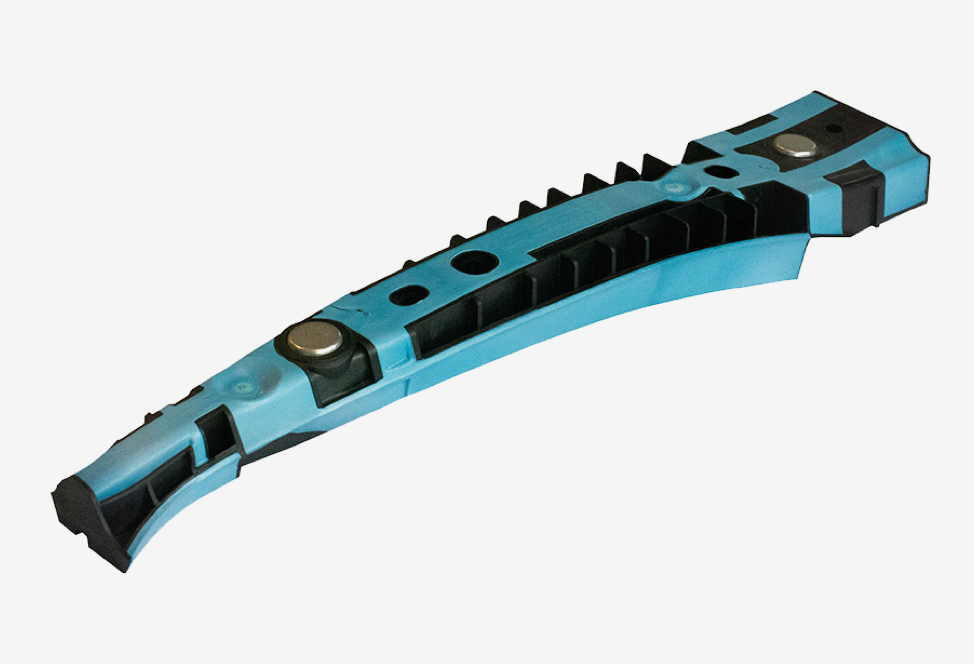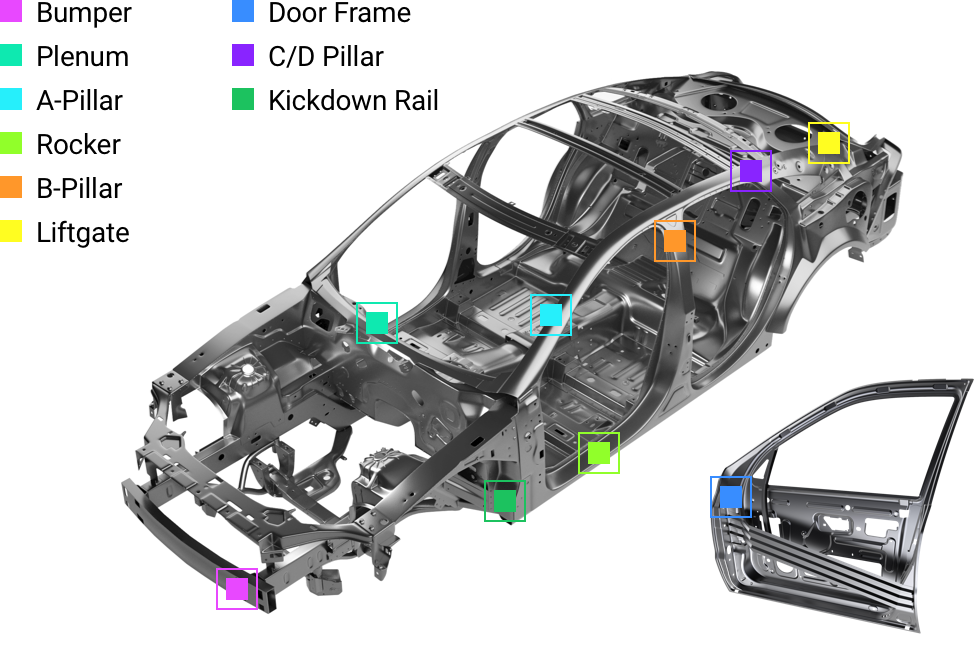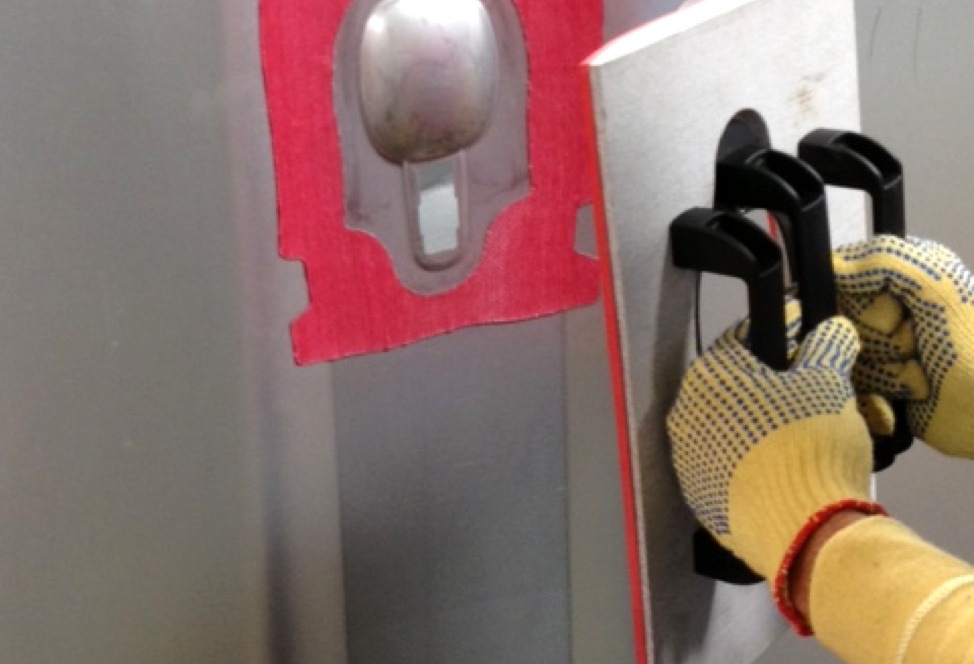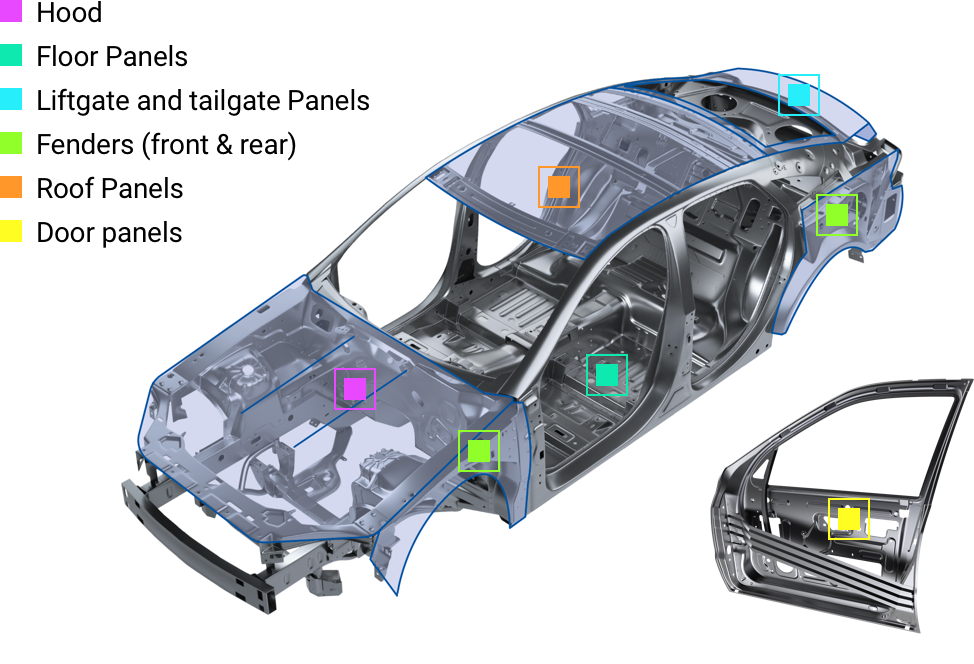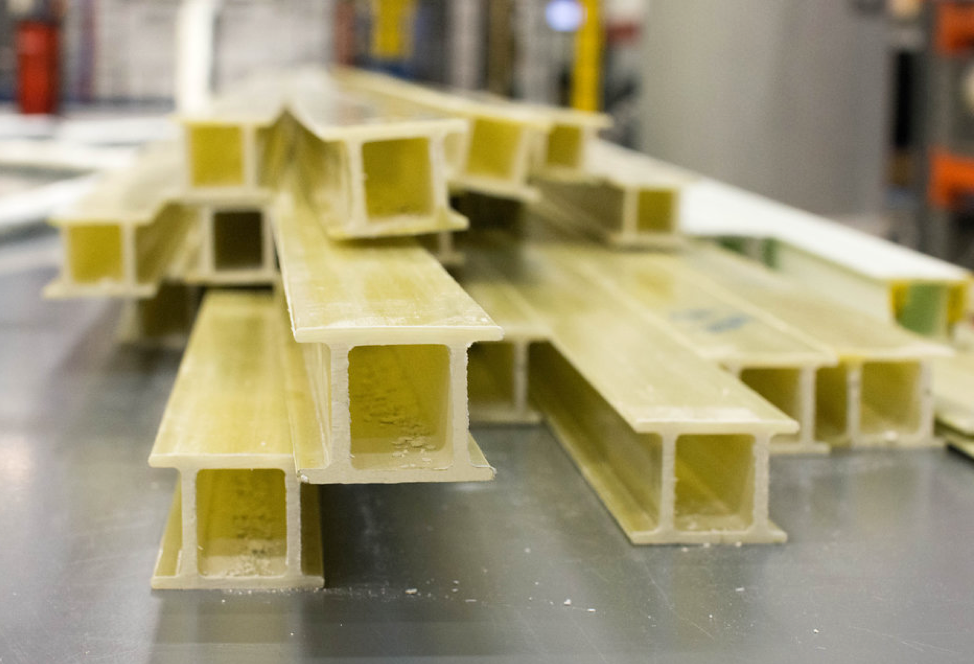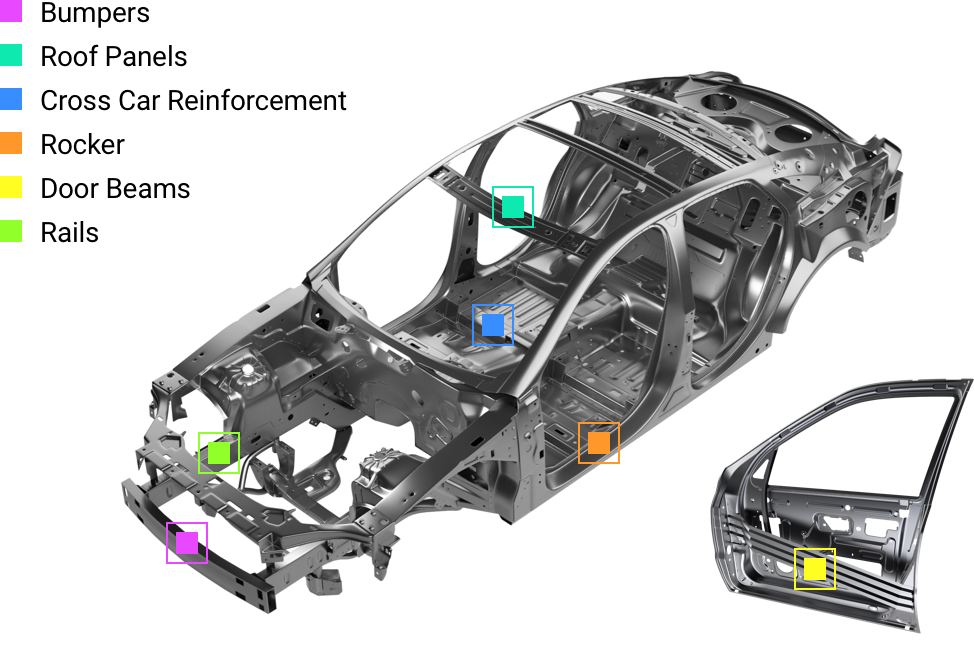Providing Custom Engineered Solutions for the Automotive Industry
We partner with automobile manufacturers around the globe to provide custom-engineered solutions that are designed to improve crash/structural performance, reduce overall noise, vibration, and harshness (NVH), and reduce the weight of the vehicle.
We develop materials that include heat-activated and ambient-curing structural adhesives, lightweight composite reinforcing structural inserts (CBS™), sealants, and thermal and acoustic management solutions.
Our highly specialized product engineers, designers and fabrication personnel bring expertise in materials science, design engineering, CAE testing and validation, innovation, and manufacturing to deliver competitive customized solutions.
Acoustic Sealing
The value of differentiated acoustic solutions in next-generation mobility solutions is clearly voiced by our customers. Consumers expect the vehicle cabin to offer low noise levels, enabling effective voice communications or infotainment functionality.
The L&L simulation team helps you engineer acoustic sealing solutions, using technology designed to minimize the amount of exterior noise entering the interior of a vehicle. Reliably sealing the body cavities at key locations in the vehicle results in an improvement in overall acoustic performance and a quieter, more pleasant cabin environment.
Our well-established portfolio of acoustic sealants is formulated to produce varying levels of volumetric expansion and density, and can either have an open or closed cell structure to satisfy application challenges, large or small.
Parts can be processed by injection molding to produce three-dimensional shapes, profile extruded or die cut. The technology enables a lightweight, high-performance engineered solution to seal the most complex cavities.
L&L’s acoustic products are usually installed in the body shop prior to the e-coat process. After the e-coat has been applied to the body structure, our heat-activated sealants expand during the e-coat bake cycle so that the entire cavity is completely, reliably, and durably sealed. Our products’ typical applications include front fender cavities, pillars, roof rails, and rockers.
Our products also provide superior performance for anti-flutter applications. By applying our sealant products to roof bows and door beams, exterior body panel vibration and noise is significantly reduced, resulting in a comfortable passenger experience.
Key product attributes:
- Improved vehicle acoustic performance
- Complex cavity sealing
- Anti-flutter capability
- Engineered designs
- Lightweight
Environmental Sealing
In addition to enhancing vehicle durability by preventing water ingress, effective environmental sealing creates value by preventing pollutants or odors from entering the vehicle cabin.
Our foaming sealants are designed to completely fill and seal a cavity in the body structure to prevent water, air, dust, and fumes from intruding into the passenger and trunk compartments of a vehicle.
Our foaming sealing products are formulated to have superior adhesion to various substrates found throughout the body of a vehicle, such as steel, aluminum, magnesium, including contaminated surfaces such as oily metals.
Typical application areas include pillars, roof rails, rockers, and fuel fillers. The products are usually installed in the body shop prior to the e-coat process. After the e-coat has been applied to the body structure, our heat-activated sealants foam during the e-coat heating cycle until the cavity is completely and reliably filled.
Parts can be processed by injection molding to produce three-dimensional shapes, profile extruded or die cut. The technology enables a lightweight, high-performance engineered solution to seal the most complex cavities.
Key product attributes:
- Improved environmental durability
- Complex cavity sealing
- Superior adhesion properties
- Engineered designs
- Lightweight
TRI-Seal® Technology
Our TRI-Seal® technology is a multi-faceted approach combining three desirable attributes:
- Isolation of dissimilar substrate materials to be joined, to prevent galvanic corrosion
- Sealing to prevent water, air, or dust intrusion into the join location, to avoid corrosion, and prevent water leakage into the vehicle cabin
- Torque retention to maintain mechanical fastener tightness, for example due to high vibration
Our formulations introduce non-conductive rigid spheres into foaming sealant materials. The sealant materials may be dry-to-the-touch or tacky.
For the dry-to-the-touch, the sealing material is heat-bonded, and has a thickness less than the spheres’ diameter after fastening compression to ensure contact with the metal.
The tacky material option is pressure-sensitive and utilizes a thicker seal so the material can flow under clamp load to ensure maximum sealing coverage. Torque retention is achieved by the rigid spheres being compressed by the opposing substrates.
Typical TRI-Seal automotive application areas include door hinges and strikers, hood hinges and latches, lift and tail gate hinges, and bolted and riveted attachments.
Key product attributes:
- Mechanical fastener sealing from water, dust, and air
- <3% torque fall-off
- No conductivity or galvanic corrosion
- 0.5 mm thick
- Dry-to-the-touch or tacky material options
- Can be heat-bonded (for dry solution)
- Pressure-sensitive (for tacky solution)
Extrude-in-Place system
Our customers desire repeatable, reliable, and efficient production methods.
Our Extrude-in-Place technology (XiP®) was developed to provide the ultimate solution, combining L&L’s custom formulated chemistry with the capability of a fully automated application process. It involves dispensing L&L sealing material formulations directly to a metal substrate using a robotic extrusion process.
All XiP®-compatible materials from our portfolio are formulated to be dry-to-the-touch immediately after being extruded onto the substrate (for trouble-free handling) and superior green-state adhesion (no e-coat wash off). Like many of our products, XiP® materials are thermally activated to foam in the oven during the e-coat curing process.
The technology offered is well-known for applications of varying complexity. It is ideal for large parts and multi-dimensional sealing applications that require precision combined with reliability to accommodate varying build conditions.
XiP® is commonly used to seal areas where eliminating water intrusion, air, dust, and fumes into the vehicle is difficult. Alternatively, when applied to door beams or roof bows, for example, XiP® coupled with our acoustic sealant technology significantly improves the acoustic performance of the vehicle by damping vibration between adjacent body panels.
Key product attributes:
- High efficiency, repeatability, and reliability
- Versatile design capability
- Dry-to-the-touch upon application
- Superior green-state adhesion
- Improved acoustic and sealing performance
DECI-TEX® Non-Woven Acoustic Materials
In addition to our heat-activated acoustic body treatments, we offer fiber-based DECI-TEX® technology with enhanced and customized acoustic functionality to trim components in order to improve in-cabin sound quality. Voice-communication or infotainment activities make low in-cabin noise levels increasingly important.
Combining decades of expertise in polymer science, non-woven fiber manufacturing, and automotive part design, DECI-TEX® sets a new standard at OEMs for delivering lightweight, cost-effective acoustic performance using sustainable, recyclable materials.
DECI-TEX® T is a rigid compressed non-woven that can be formed into self-supporting trim or other components where acoustic absorption is desired, such as:
- Instrument panel close outs
- Trunk trims
- HVAC ducting (airflow noise)
- Wheelhouse liners (tire noise)
DECI-TEX® V provides acoustic insulation behind traditional trim components including:
- Roof, hood, doors, and tailgate
- Instrument panel and console
- A/B/C pillar
- Carpeting
- Trunk trim load floor and package tray
Key product attributes:
- Enhanced, more predictable and tunable acoustics
- Sound absorption over a wider frequency range versus faced foams or other traditional acoustic materials
- Higher stiffness and load-bearing capability with DECI-TEX® T, increased temperature resistance, and ability to be overmolded
- Exceptionally low VOC emissions
- No buzz, squeak, or rattle
- No moisture or odor issues
- Recyclable
Structural, semi-structural, and elastic adhesives
In response to the automotive industry’s desire for lower vehicle weight combined with improved structural performance, we have developed a wide range of adhesives that enable combinations of materials, including steel, aluminum, magnesium, glass- or carbon-fiber composites, and plastics.
L&L Structural bonding adhesives are commonly used to replace or enhance existing joining techniques such as welding and mechanical fastening. Beyond that, they have the ability to bond areas of the vehicle with limited weld robot accessibility, varying design tolerance gaps, and joints consisting of dissimilar materials that cannot be welded typically. Our structural adhesives can improve the overall performance strength and durability of the body structure.
Our heat-curing structural products are applied even to oily metal, prior to the e-coat process, and designed to cure in the e-coat bake oven. We are also able to offer non-heat-curing structural adhesive solutions for applications where no oven bake is utilized.
Our Semi-Structural adhesives are suited to body, panel, or trim bonding, enabling replacement rivets, bolts, or other mechanical fasteners, as well as providing an alternative to plastic-welding methods. L&L is focused on developing faster-curing, lower-toxicity alternatives to traditional semi-structural adhesives, while eliminating substrate pre-treatment steps in many cases.
When bonding dissimilar materials, our adhesives are designed to accommodate differences in coefficient of linear thermal expansion (∆CLTE) as well as maintaining substrate separation to prevent galvanic corrosion. Our elastic adhesives offer increased joint flexibility for bonding multi-material assemblies, while maintaining the ability to bond a wide range of different substrates without pre-treatment.
For optimal application, our adhesives are available in several forms, including tapes, pastes, films, and patches (continuous and die-cut).
Key product attributes:
- Structural, semi-structural, and elastic adhesives
- Heat curing or non-heat curing
- Ability to bond dissimilar substrates without pre-treatment
- High strength, ductility, and toughness
- Weld-bonding-compatible (heat cured adhesives)
- Enables lightweighting
Structural reinforcement
L&L CBS (Composite Body Solutions)
L&L introduced CBS technology to the transportation industry over 20 years ago. It is still the clear global market leader. With close collaboration with our customers, L&L provides engineered solutions for crashworthiness, local and global stiffness improvements, and vibro-acoustics or durability enhancements for all types of vehicles.
Similar to natural bone structures, our CBS structural reinforcement technology offers an optimum balance of structural performance versus light weight for each application when compared to traditional manufacturing methods and alternative reinforcements.
L&L CBS solutions combine our structural adhesives expertise with advanced CAD/CAE simulation expertise to design and manufacture three-dimensional engineered parts optimizing design and materials. The result is a structural insert that is dry-to-the-touch and ready to assemble into the body structure prior to cavity closure and e-coating. Our foaming structural adhesives allow for e-coat flow and coverage of the cavity prior to adhesive foaming in the e-coat bake oven.
CBS parts are commonly used to enhance overall body-in-white stiffness. A CBS three-dimensional part with multiple structural adhesive connections to the body cavity can produce efficient stiffness increases that can be used to improve the comfort or safety level, or enable removal of less efficient reinforcements. This lightweight stiffness can be achieved at neutral cost compared to heavier traditional metal solutions.
During a crash event, our CBS structural inserts provide a desirable combination of section stability, load path transition, multi-axis load management, and energy absorption. The optimization of body sections with CBS parts allows an efficient body design, minimizing the deformation of the structure for reduced intrusion into the passenger or battery space.
CBS reinforcements can eliminate localized durability problems, such as metal fatigue, by increasing overall stiffness and distributing loads more effectively across the structure. Improved NVH performance is also commonly achieved when our CBS structural reinforcement technology is integrated into the body structure. Again, careful engineering analysis allows development and location of optimal solutions to optimize vehicle ride and handling characteristics.
It is also common to use the design flexibility of CBS parts to simplify the process in areas of complex or difficult-to-access assembly conditions. For example, using CBS for doors and closures can offer weight savings and stiffness gain, but can also help to simplify door manufacture if taken into consideration in the design process.
Our CBS technology is a multi-faceted approach combining four desirable attributes:
- Frontal/small overlap crash
- Side impact (including pole impact)
- Rear crash
- Roof crush
Key product attributes:
- Optimal balance of structural performance versus design weight
- Compatible with traditional e-coat body process
- Enhanced crashworthiness via high load bearing, load transition, multi-axis load management, and energy absorption
- Increased stiffness for acoustic vibration performance
- Improved joint or section durability
Composite Panel Stiffener
Our Composite Panel Stiffeners incorporate a foaming structural adhesive, usually within a high-stiffness fiber reinforcement. It is designed to improve stiffness (lack of panel rigidity leading to “oil canning”) and NVH (excessive panel vibration and noise) problems, especially in large or relatively unsupported panels.
With strong focus on lightweighting and downgauging of body panels in next-generation vehicles, noise associated with panel vibration would negatively influence customer perceptions of quality.
Using modeling, our engineers can determine the ideal size and location of the composite panel to provide optimal pricing and performance.
In its green state, panel stiffeners provide excellent initial adhesion coupled with pliability, which allows for application to non-flat contours. The product is installed in the body shop prior to the e-coat process and activated by e-coat bake oven heat. Once activated, the high-performance stiffening is enabled by the increased moment of inertia via foaming to increase the stiffener thickness.
Ideal application areas include door panels, roof panels, hoods, fenders (front & rear), lift gates and tailgate panels, floor panels, and battery casings.
Key product attributes:
- Enables thinner gauge panels to be used, thereby enabling overall weight savings
- High-performance panel stiffening and vibration reduction due to increased moment of inertia
- Superior green-state adhesion to a wide range of substrates
- Ability to apply to complex contours, for example around corners
L&L CCS
(Continuous Composite Systems)
Based on many years of structural reinforcement of metal assemblies, L&L has demonstrated our Continuous Composite Structures (CCS) are able to provide lightweight alternatives to metal frame structures.
Continuous Composite Systems (CCS) are continuous fiber-reinforced composite materials that can be used as a carrier when combined with our highly engineered sealants and/or structural adhesives. They are constant cross-section pultruded profiles designed to provide strength, stiffness, and rigidity to a lightweight structure.
CCS offers a number of unique attributes in terms of material and fiber choice, supported by our advanced CAE define modelling to drive custom-engineered solutions for a variety of applications. These include reinforcing members for vehicle uni-bodies, frame sections for tube-frame vehicle constructions, or battery frames for electric vehicles.
Key product attributes:
- Reduced weight: up to 75% lighter than steel; 30% lighter than aluminum
- Consistent quality due to continuous process method
- Cost competitive with alternative lightweight solutions
- Eliminates need for anti-corrosion coatings
- Nonconductive and insulating
- Low co-efficient of thermal expansion
- Excellent structural properties
- High predictability in energy management

